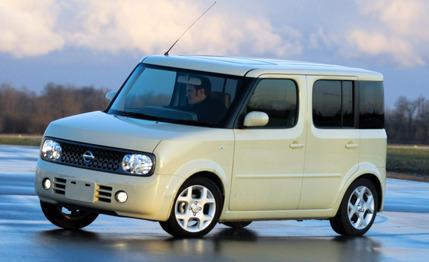
 Specialty File
Specialty File
The Nissan Cube might be the squarest car on the planet—it’s 65.8 inches wide and 65.0 inches tall. The boxy second generation of this little economy car was introduced in Nissan’s home market in 2004, but like Admiral Yamamoto’s fleet, it never made it to U.S. shores. A new third-generation Cube, however, is headed here in 2009. To check out the shape of this particular thing to come, we ran the current Japanese-market Cube through the C/D meat grinder.
As you’d expect, it’s adorably cubelike. But along with the dimensional symmetry comes a distinct asymmetry in the design. For one, there’s no glass on the driver’s-side D-pillar, and for two, the passenger-side glass wraps around to the tailgate.
The Cube is small. Its 146.9-inch length is only 0.7 inch longer than that of a Mini Cooper S and more than 20 inches shorter than the length of that other automotive box, the Scion xB. But being nearly 10 inches taller than the Mini and using all of its width, the Cube is more spacious inside. Passengers sit upright, like in a chair. In the rearmost position, the back seats offer comfortable accommodations, and they also slide forward to make more cargo space. The seats are covered in a rattan-like fabric that feels more suited to an apartment than a car.
It’s appropriate, then, that the Cube converts into a makeshift living space. The front seats—a two-person bench—fully recline and meet up with the rear seats (which partially recline) to create a giant chaise lounge perfect for hormone-crazed teenagers (as long as they’re not yours) to get their swerve on or for an out-of-work mortgage banker to use as a temporary domicile.
Whether or not you need to hide the shame of living in your car, the Cube has plenty of bins to hide your stuff. We noticed two glove boxes with a shelf in between, two bins in the center of the front seat (one in the armrest and one in the seat bottom), a small shelf under the steering wheel, and a tray next to the steering wheel. The emergency jack and inflation kit are stashed under the floor of the rear-seat footwells.
Our Japanese Cube is powered by a 95-hp, 1.4-liter inline four-cylinder driving the front wheels. Supplemental traction is provided by an electric motor on the rear wheels (called e-4WD by Nissan) that’s powered by an engine-driven generator. Since the device sucks power from the engine, it doesn’t help acceleration. There’s an optional 107-hp, 1.5-liter engine, but we doubt the extra 12 horses would do much to rejuvenate the lethargic Cube. Around town, the Cube can keep up with the flow of traffic, but to get up to highway speeds it’s almost Smart-like in its torpor, although the Cube’s extra size makes overtaking howling semis less nerve-racking.
Unlike the Smart, the Cube is a fully usable car underneath its toylike appearance. And unlike the Americanized Scion xB, the Cube has the oddball, whimsical sense of design found in cars available in the Japanese domestic market but mostly absent from cars sold here in the U.S.
If the current version is any indication, the upcoming Cube should start below $15,000 and deliver more than 35 mpg during highway driving (our observed figure of 22 mpg reflects the fact that we had to drive flat-out to keep up with traffic). All the U.S.-bound version needs is a bump in power over that of the current Cube and an extra gear or two in its transmission. Any other changes might dilute the inherent charm that comes from the Cube’s combination of delightful eccentricity and high usability.